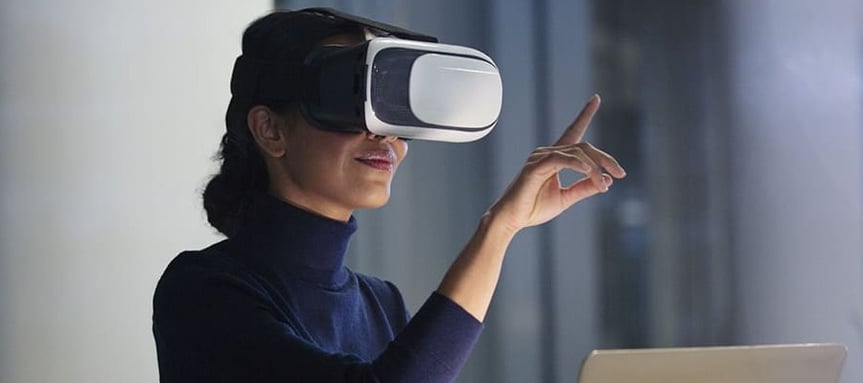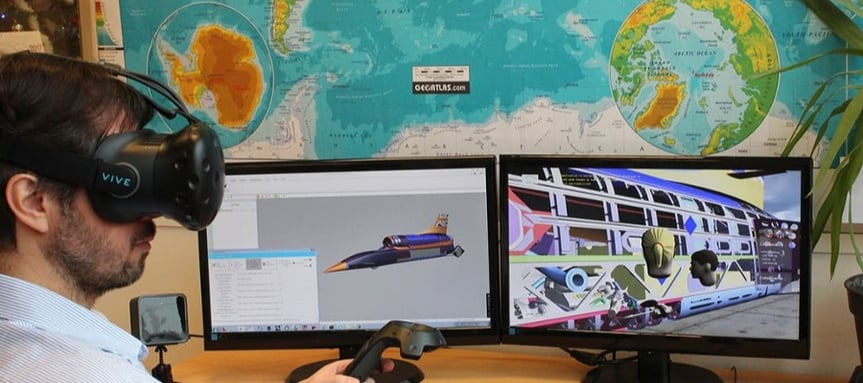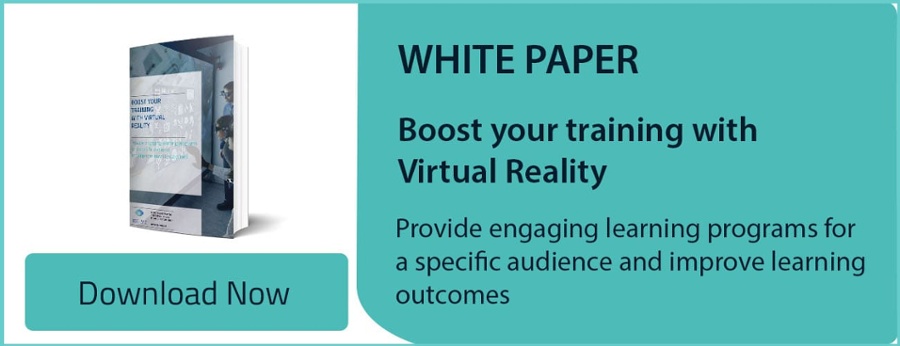
While Industry 4.0 affects production lines and machines, it is also a challenge for operators. With the happening of modern plants, the increase in automation and robotization, their environment has become more and more complex, and they must adapt fast. To keep working efficiently, not only they need new skills and tools and so they need to be trained, but also solutions to improve their decision-making processes. With the ability of virtual technologies to provide 1:1 scale virtual machines that you can interact with, it is possible to be trained as if being in a real plant, interacting with real machines. Decision makers can visualize and analyze every step of an operation and improve them without having to go through the whole physical prototype making process. Thus virtual reality appears to be the adequate solution to improve field operators efficiency.
There are three main activities where AR/VR systems can help technicians perform better: training before they take up their job, remote collaboration while working and remote maintenance.
1. Operators VR training to pick-up skills faster
As factories are becoming smarter every day, skills required for operators are getting harder and more technical. Because of automation and complexification of the equipment, operators are more likely to misinterpret or make bad assumption regarding the equipment. They must be very aware of their (new) work environment to ensure the productivity and the safety of their plants.
With traditional training methods, reaching an expert level for an operator can take 2 to 4 years. On the other hand, a study from PWC shows that to acquire the same skill, it respectively takes :
- 2 hours in a classroom setting
- 45 minutes via an e-learning module
- 29 minutes with virtual reality training
VR training in the manufacturing industry offers an easier access to a repository of a factory know-how. Instead of learning in groups with a trainer, each technician can wear a VR headset and experience different training scenario. This way, whenever he gets something wrong, the VR training software can be tailored to his individual needs and progression.
The most challenging for operators is to handle unusual or rare situations, such as unexpected start-ups of shut-downs of the factory line, for example. Of course, these cases can’t be covered in real life without actually slowing the production down. Neither can they be properly addressed during a theoretical course. That’s where using VR for training would be a perfect solution : virtual reality is ideal for all scenarios that are too expensive, too dangerous, or impractical for a traditional setting.
Virtual reality simulations replicate the real world, so the technician is fully immersed in a real-like simulation. With the use of a CAD model of the plant (or a laser-scanning), he can experience the scenario in the 3D representation of his workplace. It is an ideal set-up for his training, as he can experience the same anxiety and concerns as if he was in real life, but without the safety or production issues. It helps for memorizing the new information as well as how to use it in a real-like context.
2. Remote collaboration in VR to complete difficult tasks
In complex and collaborative tasks, such as setting up an equipment, local technicians may need to complete their operations under the guidance of remote experts. However, flat screens and classic collaboration tools such as Teams or Zoom can get very limited when working with 3D data. Getting access to the same 3D data gives more insight and information to the workers. Therefore, Virtual Reality is ideal for remote collaboration sessions.
For instance, geographically distributed companies can use immersive collaborative virtual environments to run a design review within the large-scale model of a product, such as a plane, a boat, or a building. By using VR headsets, or immersive rooms, they can provide more accurate information to all the stakeholders. This feature can become essential to configure the equipment on an assembly line or make a quality checkup.
A VR collaboration platform addresses two main issues:
- Multi-site collaboration: operators can work directly with engineers or experts located on other sites
- Mono-site collaboration: operators in the same location can visualize the 3D CAD models in VR together and get all the data they need without a complex VR system (two VR headsets can be enough, depending on your use case)
Enabling your collaborators (experts, engineers, and operators) to collaborate easily with an AR/VR system will shorten the design process and the setup of the production line. Viewing the CAD models used for your products, equipment and factories in VR will enable your teams to connect easily with the right person, and transfer critical information about the design, production, assembly, or quality. It will help improve and fasten your processes and save time and resources.
3. Remote maintenance

In industry 4.0, a quick and efficient production system needs to rely on an equally efficient maintenance system. With the happening of robotization and IoT, factories and equipment are getting “smart”, and can now alert the technicians much sooner if they detect a risk.
Augmented and virtual reality software are also powerful tools when it comes to remote maintenance. They can help training the operators by immersing them in their own 3D data, which is especially useful when it comes to products with bespoke adaptations, such as boats. They can also serve as a tool for remote collaboration between the experts and the local technicians when an issue arises.
To help the technicians perform better in maintenance, a VR software for industrials should provide:
- The possibility to compare the actual equipment (in the form of a 3D point-cloud or a laser-scanning) viewing CAD models in the same VR environment
- The possibility to take notes, measurements, and photos inside the VR environment, to help the people exchange information without any misunderstanding. It is a crucial feature for global companies with factories in different countries.
- The possibility to track and record the positions and moves of technicians doing the maintenance (with the help of wearable devices like a body tracking suit). If the failure is likely to happen again, it will provide meaningful information.
Some companies are getting very serious about the opportunities that Virtual reality presents for the future of their business. VR can help operators throughout all their tasks, whether it is virtual assembly, remote maintenance, or VR training. Now, the only limit of businesses is to figure out what their customers want and how to best deploy VR software in their field for remote collaboration, maintenance, and training.






 Back to Blog
Back to Blog




